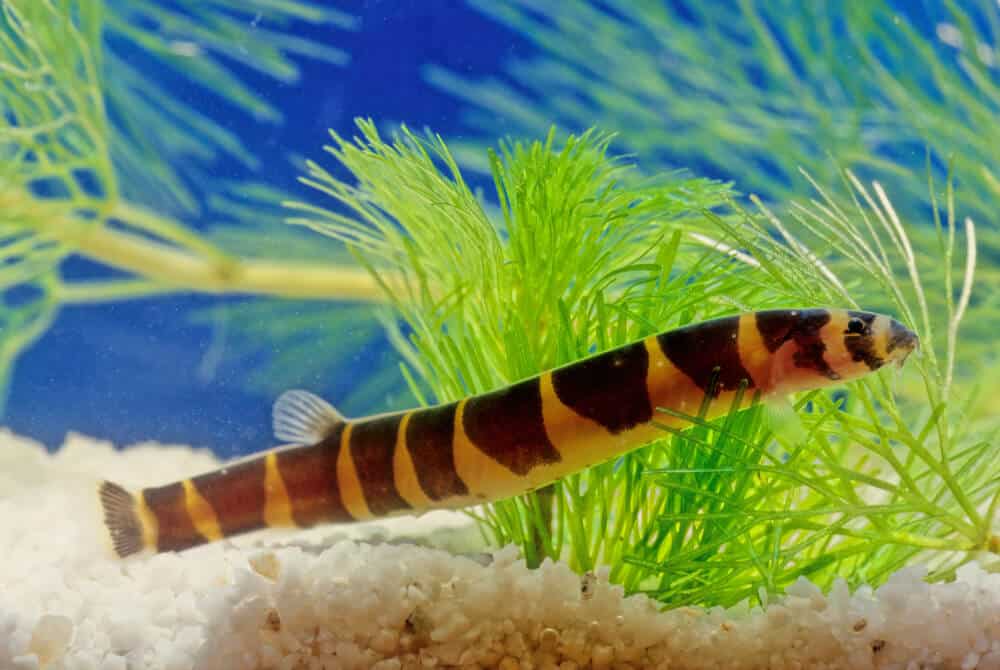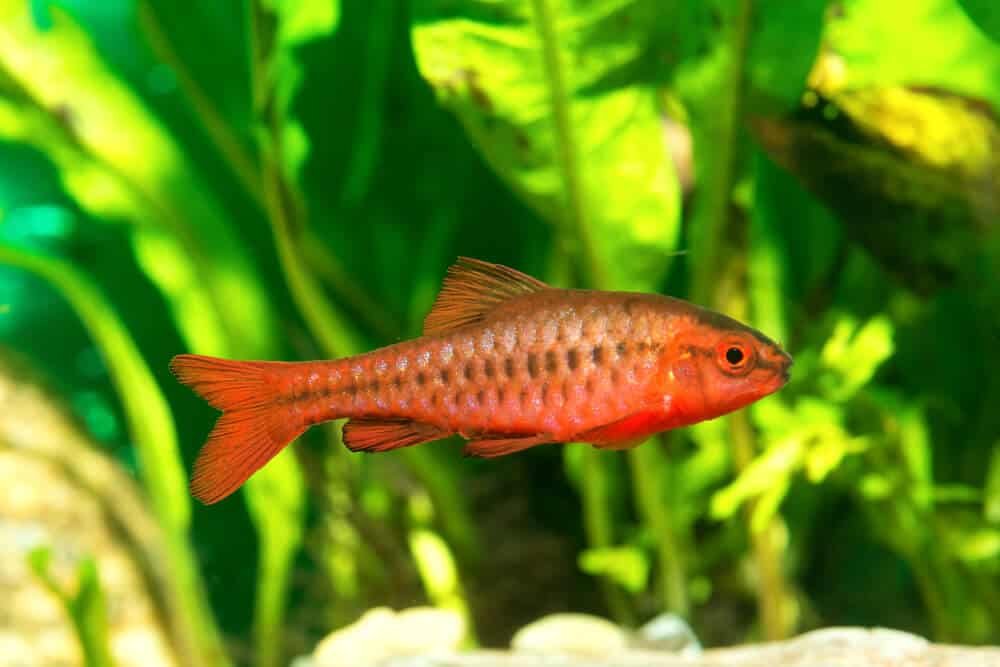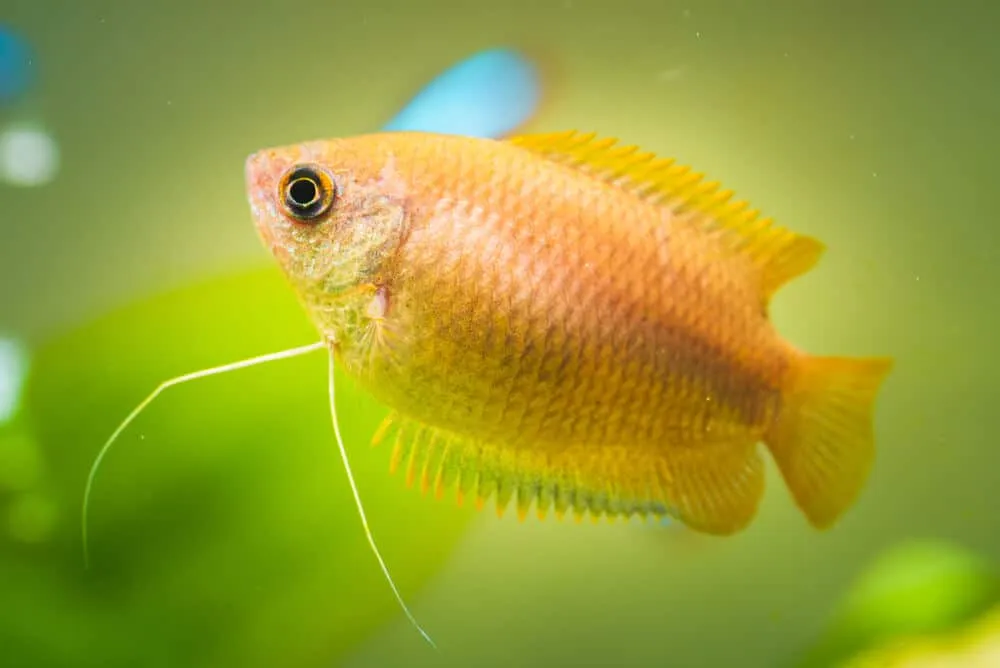Kuhli Loach, also known as leopard loach or coolie loach, are small bottom-dwelling eels-like that live peacefully in freshwater. This fish species is timid and a good cleaner fish that can be a good companion with others. However, they can be challenging to keep, especially for beginners.
This article will get a deep dive into what you must know when it comes to caring for Kuhli Loach and their best tank mates.
Overview
Kuhli Loach is a tropical and unique fish commonly found in freshwaters in Southeast Asia places such as Borneo, Thailand, and Malaysia.
This species was first discovered in 1846 and belonged to the family of Cobitidae. They are also considered one of the oldest fish globally and were a good source of everyday food for early Indonesians.
This creature has an eel-shaped body and measures 4 inches in size. The Kuhli Loach is an excellent addition to your aquarium. This is because they are scavengers and can be great cleaners for the aquarium.
Furthermore, they don’t produce so much waste, thanks to their small size. They can also do well in shared tanks.
Lifespan
Kuhli Loaches can last up to 10 years if cared for properly. These fish species are more prone to diseases; hence, they need to be cared for by an experienced aquarist. It would help if you considered their scaleless head when giving medication as they can be susceptible.
Furthermore, once you decide to buy them, you know the species’ scientific name. Also, always check for signs of disease or injury before buying and ensure that you only get the healthy ones.
Another thing to watch out for is their physical appearance. Check for any faded colors, unusual behavior, and strange markings.

What Does The Kuhli Loach Look Like?
One of Kuhli Loach’s most known features is their slender body. At first look, you can mistakenly identify them as eels since they have thin bodies and tiny fins that cannot be seen easily.
They can measure 3 to 5 inches and won’t take a lot of space in your aquarium. Although a mature Kuhli Loach can get up to 5 inches in the wild, they typically stay between 3 to 4 inches when placed in an aquarium.
Unlike most fish, the visible dorsal fin of the Kuhli Loach is found further back the middle body. The Kuhli Loach has four pairs of barbels in the small fins and mouth.
You can see Kuhli Loaches in different colors. The base of the fish is colored pink to yellow, and the underneath is lighter. On the top part, its color has 15 stripes darker.
One strange characteristic it has is its indistinct body scales and scaleless head. Although unique, this characteristic makes them prone to diseases.
Moreover, both genders appear the same when not breeding actively. However, males can be identified by their large pectoral fins and more muscular dorsal cross-section. Also, females tend to get larger when breeding.
Behavior
As mentioned, Kuhli Loaches are peaceful, quiet, and shy, and you can rarely see them alone in the aquarium during the daytime.
They love to hide in dark and secluded places like under logs. Nevertheless, they are quite active at night. They also love to hide when they are injured, sick, or don’t want to socialize.
Kuhli Loaches are quite social on their own and like to feed in groups. They may also be comfortable with other fish at the bottom of the aquarium, where they go to scavenge for food. They are also very curious and love to hide in crevices and caves.
Caring Guide
As mentioned before, the Kuhli Loach is more prone to diseases and infections. This is because they do not have hard scales to protect them against fungi and bacteria, unlike most fish. Hence, caring for this type of fish can be challenging, especially for beginners.
Similarly, Kuhli Loaches are prone to Ich, a disease that is caused by a parasite. When this fish disease affects your Kuhli Loach, it can quickly spread in your aquarium.
The first sign of this disease is small white spots in the fish’s body. Unfortunately, Ich can be deadly to fish if not treated on time. Hence, it would help if you cared for your Kohli Loach to keep them healthy properly.
Make sure that you provide them with quality water, a great diet, and a superb environment. Without these necessities, Kuhli Loaches will encounter diseases and get stressed easily.
Fish can be very sensitive, especially when the water changes. As a result, you need to carefully consider the temperature and quality of the water when adding new members of Kuhli Loach to your aquarium since they tend to be susceptible to changes and medications.
As a result, their life span and health will surely depend on how you care for them.
Make sure that the water is clean and well-oxygenated. Also, try not to use chemicals as they can be harmful to your Kuhli Loach.
Setting Up A Tank For The Kuhli Loaches
Keeping well-oxygenated and clean water is crucial. As for Kuhli Loaches, they need soft substrates like gravel mix and sand.
The water requirement should be 0-5 dGH, smooth, slightly acidic, with moderate lighting, and a pH of 5.5-6.5. Since they are tropical species, water with a 73- 78 degrees Fahrenheit temperature would be ideal.
To reduce waste and improve oxygenation, it is recommended to place a gravel filter underneath. Additionally, you need to ensure that there is adequate water movement.
Generally, you should use a filter to ensure a turnover of at least ten times every hour. Also, when setting up a tank for your Kuhli Loaches, ensure that the filters have a cover on top of the outlet and an inline pipe. This helps to avoid Loach swimming and eventually getting trapped inside.
Bear in mind that you should imitate the environment in the wild where this fish comes from in your aquarium.
For instance, you can set fern plants and Cryptocoryne. You may also want to scatter peat moss to offer security and provide a breeding space.
If you fancy some decorations, you can use driftwood pieces, large rocks, and twisted roots for them to hide.
· Filtration
Setting up a tank requires excellent filtration to help maintain water quality for your Kuhli Loaches. Also, it would be best if you kept lighting, temperature, acidity, and oxygen level well maintained based on the behavior of your Kuhli Loach.
· Substrate
Sand substrate makes the best substrate for your Kuhli Loach. They typically dig around the sand substrate to make a natural environment. Hence, it is best to cover your aquarium with mesh on top.
· Minimum Tank Size
To avoid future issues, the preparation of the tank is essential. The tank size for Kuhli Loach is 15 gallons since they are small. But if you wish to add more, you can add 3-5 gallons for every additional Kuhli Loach.

Diet And Food
Kuhli Loach’s diet is effortless to maintain. They are scavengers by nature, and this means they can consume almost anything.
In their habitat, they clean riverbeds and eat everything like plant remnants and small shrimps. These creatures serve as a filter naturally.
This species loves to scavenge underneath their habitat until they consume something edible. A similar thing occurs when in a tank. They feed after sundown and need up to 3 feeds per night. But it doesn’t mean that you are not going to feed them with real food.
Kuhli Loach loves to consume fish foods that are protein-based, much better if they are live foods.
Some popular choices are water fleas, bloodworms, tubifex, and brine shrimp. They can also eat algae, spinach, lettuce, micro bloodworms, small shrimp, and carrion.
Another food choice is feeding them with dried foods and regular pellets. However, it would help if you made sure that these foods could go down at the bottom. This is because this fish species love to scavenge at the bottom and will not go up and around to swim looking for food.
How To Breed Kuhli Loach
Breeding Kuhli Loaches can be challenging as they require specific parameters. Their reproduction should take place in a separate tank, especially for breeding. It is possible to recreate the proper way by creating an aquarium similar to a natural breeding ground.
Here are the parameters that you must bear in mind when breeding Kuhli Loach:
- A 10 gallons capacity breeding tank with a height of 15 to 20 cm is required.
- Keep water at low levels in a dim light.
- It would be best if you left them with a lot of food to motivate spawning.
- The PH level of the water should be lower than 6.
- A perfect ratio of two males to one female Kuhli Loach should be in place as they are shy when alone.
- After spawning, the parents should be out of the breeding tank as they might eat their eggs.
Moreover, you can quickly identify pregnant Kuhli loaches as you can see their eggs in their abdomen from the outside. It usually takes a day or 24 hours for the eggs to hatch, and in four days, you can see them swim and eat.
As mentioned, it is not simple to reproduce Kuhli Loaches in your tank without experience and expertise.

The 16 Best Kuhli Loach Tank Mates
The perfect aquarium fish mate that can be kept with Kuhli Loach is more of the same species. Although they are peaceful fish, they love to be around other non-aggressive species.
Kuhli Loach is an excellent addition to your freshwater tank since they are playful, small, can be with others just fine, and do not produce waste.
If you are searching for non-aggressive Kuhli Loach Tank Mates, there are several breeds that you can consider. They include:
1. Corydoras Catfish

Corydoras Catfish is peaceful and best mixed with other small fish species that are non-aggressive, like Kuhli Loach. Similar to Kuhli Loach, they also spend time underneath scavenging for food.
2. Common Molly

Another freshwater species is Common Molly. This fish is easy to care for and can be mixed with other fish with ease. Similar to other fish, they love to be in a group.
Common Molly is not aggressive by nature, but they can be if the tank is too small and other fish are close enough. They require a three gallons space for every additional fish.
3. Rasboras

There are several reasons to choose Rasboras when considering Kuhli Loach Tank Mates. This shoaling fish loves to be with other fish of similar species, in a group of about ten or more. Better yet, it requires very little maintenance.
4. Danios

Danios are active fish and love to stay anywhere and swim around the tank. They are perfect tank mates with active fish like Kuhli Loaches.
5. Tetras

Tetras stand out because of their colorful appearance and peaceful nature. However, these tropical freshwater fish come with specific diseases, making them vulnerable and challenging to maintain.
6. Gouramis

If you are looking for a middle swimmer fish, Gouramis is a great option. Although Kuhli Loach is a bottom-dweller, a middle swimmer like Gouramis is a good tank mate because they won’t interact much.
7. Bettas

Betta fish is also a good mate, only that it can be challenging to care for. This fish is known to be highly aggressive, especially when it feels that a newcomer is invading its territory. But it can still be possible to introduce additional species by getting a larger tank and bringing in fish slowly.
8. Cherry Shrimp

If you want to add color to your aquarium, the Cherry Shrimp is worth considering. Like Kuhli Loach, they are also a natural cleaner and peaceful, making them a perfect tank mate.
Furthermore, they love to consume algae that build in your tanks without harming your aquarium plants.
9. Dwarf Otocinclus

Also known as otos, Dwarf suckers are catfish that originated from South America. This fish stands out because of its sucker mouth under the belly. Like the Red Cherry Shrimp, this species enjoys eating algae.
They also spend their time holding the glass tank tightly and are quite unsocial. This makes them a good tank mate to the Kuhli Loach.
10. Guppies

Guppies are multicolored and have varying maintenance needs depending on which type of guppy you’re getting. They can be low or high maintenance. They also make good companions to other fish like Kuhli Loach.
11. Clown Loaches

This species is very much similar to Kuhli Loaches. They are also peaceful fish and prefer to be in groups, so make sure to keep them in the company of other fish.
They are like Kuhli Loaches that spend time at the bottom, but they can be mixed with this species just fine.
12. Discus

If you’re looking for an exciting, fun, and beautiful fish in different colors, then Discus is the right choice for you. They appear to be rounded with various colors such as blue, yellow, and red.
They are like pop-art pancakes and can be an excellent companion to your Kuhli Loaches. However, they cannot be mixed with many different species as they can get aggressively overwhelmed.
Always keep them in 4 to 5 groups to socialize and develop their personality, which means bright and beautiful new friends for your Kuhli Loach.
13. Apistogramma

Apistogramma has beautiful personalities. They are very curious and love to explore their environment to find things that would interest them.
Interestingly, they love to go up to your glass tank when you watch them and follow your hand or finger when you place it on the glass. If they don’t have the right environment, they can get semi-aggressive.
You must remember to group them in 10 to 20 to get along with others like Kuhli Loach. They can thrive as long as they can be closely monitored at first.
14. Angelfish

Angelfish are easy to identify thanks to their smooth angelic shapes and stylish fins. They come in different colors and have divine personalities. As a result, they can be an excellent companion to any non-aggressive fish.
Although they tend to feed on smaller fish, they make great companions for you Kuhli Loach and cannot eat them due to their size.
You may also want to keep those noises down and make sure to keep your aquarium in a calm area as they tend to get jumpy or nervous.
15. White Cloud Minnows

There are reasons why this species is an excellent tank mate for the Kuhli Loach.
White Cloud Minnows are from China. Unfortunately, they are almost extinct because of tourism and pollution.
They also like eating algae which makes them a helpful addition to your tank, just like cherry shrimp and dwarf suckers. This species makes an excellent option for Kuhli Loaches as tank mates.
16. Aquarium Plants

Another excellent addition in your tank for your Kuhli Loach is decorations and aquarium plants. It provides Loaches a place to hide, especially when they are afraid or scared of something.
It also maintains the oxygenation level of your tank, which helps your loaches and other species to thrive.
For nocturnal creatures like Kuhli Loaches, aquarium plants will serve as their hiding place during the day, and having it can make loaches secure and comfortable.
Frequently Asked Questions
How Many Kuhli Loaches Should Be Kept Together?
As mentioned, Kuhli Loaches grow up to four inches in length, and they do not produce much waste. Therefore, you can group up to six Kuhli loaches inside an aquarium with 20 gallons of water or more so they can explore and feel safe. Besides, they are peaceful creatures, so that you can group them with other fish, like rasboras, tetras, etc.
Can A Kuhli Loach Live With A Betta?
Yes, you can have a betta and Kuhli loach fish in one tank. They can manage to be with a moody and aggressive fish like Beta by hiding. However, make sure they have enough space to survive in a tank with other types of fish.
Do Kuhli Loaches Eat Other Fish?
Kuhli loaches can survive by taking the crumbs of other fish but do not bite other fish. However, you must ensure they do not get hungry. They love sinking foods like live blackworms, frozen bloodworms, community pellets, etc. If you notice that all the other fish get the food without anything left for your Kuhli loaches, feed them during the night.
Can I Put A Kuhli Loach In A 10-gallon Tank?
Well, there is no definite answer to this question. As mentioned, you can group up to six Kuhli Loaches inside a 10-gallon container because they have low bioload or do not create much waste. They can clean aquarium waste.
However, the answer depends on the number of fish you have existing inside the same aquarium. So, yes, you can add up to six of them together without other fish. And no, you can’t put them in a 10-gallon tank with several fishes already inside.
Do Kuhli Loaches Need A Heater?
Kuhli loaches come from tropical places or freshwater with higher temperatures than usual. Therefore, the average water temperatures where a Kuhli loach can survive range from 25 to 30 degrees Celsius or 74 to 85 degrees Fahrenheit.
It would be best if you had a heater for your aquarium to keep Kuhli loaches comfortable. You need to maintain the temperature ranges all time if you want them to survive.
Conclusion
Caring for a Kuhli coach can seem discouraging initially, but it is not that scary once you get a deeper understanding of how to care for them. However, they are not an ideal fish species to start as they can be challenging for novice aquarists and may not thrive.
Note that Kuhli loaches can be excellent additions to your community aquarium, and they also do well with their kind.
Just make sure to study the species you’re interested in and monitor them closely at the start. Therefore, you must learn how to take care of them and ensure that they are healthy and can survive in the new environment you put them in.







